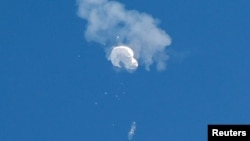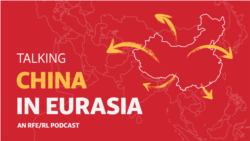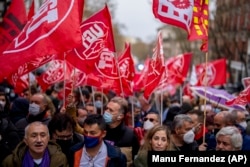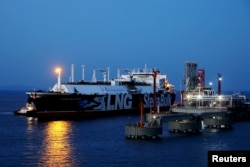
Welcome back to the China In Eurasia briefing, an RFE/RL newsletter tracking China’s resurgent influence from Eastern Europe to Central Asia.
I’m RFE/RL correspondent Reid Standish, and here’s what I’m following right now.
An Own Goal?
This was supposed to be the week in which U.S. Secretary of State Antony Blinken made a long-awaited trip to China and began dialing down tensions between Beijing and Washington.
Instead, an international incident over a Chinese spy balloon traversing the United States led to the trip being postponed and raised wider questions about deepening competition -- and the risk of escalation -- with China.
Finding Perspective: The episode may be more damaging to China’s leadership than to that of the United States.
Beijing has stepped up its diplomacy in recent months -- exemplified by Chinese leader Xi Jinping’s conciliatory tone during the Bali G20 summit in November -- as it emerges from its COVID lockdowns and looks to offer a friendlier face to quell growing resentment in some corners of the world stage.
Chinese officials have cast the balloon as a civilian meteorological device that drifted off course and decried the United States for shooting it down.
But many analysts also believe the incident has probably taken Xi and senior leaders by surprise.
Beijing gains little from sabotaging Blinken’s visit and squandering an opportunity to calm down growing military tensions and an expanding trade war with Washington, especially as China looks to kick-start its economy.
From this perspective, the balloon incident looks more and more like an own goal by Beijing.
Why It Matters: While this incident is the tip of the iceberg for the regular back-and-forth spy game between China and the United States, it’s Beijing that is left triaging the fallout.
In the United States, this has strengthened the already strong belief in Congress that China is a major threat to the country. Rising partisan hot air around the balloon also means that domestic politics will make it difficult for dialogue to pick back up any time soon.
In Europe, meanwhile, this incident will increase the growing scrutiny of China that has expanded amid Beijing's support for Russia following its invasion of Ukraine.
China has tried to signal some daylight between it and Moscow of late, but deep doubts remain in Brussels. Chinese Vice Foreign Minister Ma Zhaoxu recently visited Moscow and said that Beijing wants to work with Russia to advance their relationship this year. Xi is also expected to travel there later this spring for a state visit.
The balloon incident, coupled with continued outreach to the Kremlin, are likely to dispel any remaining illusions and make it even more difficult for Europe to straddle its sometimes awkward line between China and the United States.
Read More
- According to an analysis of Russian customs data by The Wall Street Journal and C4ADS, a Washington-based nonprofit that specializes in identifying national-security threats, “Chinese state-owned defense companies [are] shipping navigation equipment, jamming technology, and jet-fighter parts to sanctioned Russian government-owned defense companies.”
Expert Corner: China's Deflated Balloon Response
Readers asked: “Is there any evidence that this spy balloon saga in the United States caught the Chinese off guard?”
Here’s what Etienne Soula, a research analyst at the German Marshall Fund’s Alliance for Securing Democracy, has to say:
“It appears that the significance of the incident took the Chinese authorities by surprise. As late as [February 3], when foreign media questions made it apparent that the story was blowing up, the Ministry of Foreign Affairs was giving curt and dismissive answers instead of trying to get ahead of the story.
"Despite a few wolf warriors like the consul general in Belfast or the Chinese Embassy in France trying to set the tone on [February 4], the MFA only put out an official statement deploring what it deemed an [American] overreaction on [February 5]. In [the following] press conference, the Chinese MFA's spokesperson seemed once more thrown off by Western journalists’ questions about more Chinese balloons flying over other parts of the globe.”
Do you have a question about China’s growing footprint in Eurasia? Send it to me at StandishR@rferl.org or reply directly to this e-mail and I’ll get it answered by leading experts and policymakers.
Three More Stories From Eurasia
1. From Prague To Taipei
The Czech Republic elected a new president on January 28, and he’s already made waves by accepting a congratulatory phone call from Taiwanese President Tsai Ing-wen and risking backlash from Beijing in the process.
The Details: On January 30, President-elect Petr Pavel -- a former general who served as head of NATO's military committee from 2015-18 -- became the first elected European head of state to accept a call from Taiwan’s president.
Western leaders traditionally adopt an under-the-radar approach to dialogue with Taipei and refrain from direct political contact with Taiwanese authorities, typically limiting official exchanges to the level of civil servants or to individual parliamentarians.
But tensions over Taiwan and Beijing’s growing military threats toward the self-ruling island that it claims as its own territory, especially since Moscow’s invasion of Ukraine, have attached greater urgency to the issue and seen it grow in prominence across Europe.
All eyes have since been on the Chinese response, especially given that Pavel also raised the possibility on the campaign trail and in a tweet following the call of an in-person meeting with Tsai.
So far, Beijing’s reaction has been boilerplate, simply voicing displeasure with the call and urging Prague to uphold the “One China Principle.”
As RFE/RL’s Rikard Jozwiak and I unpacked in the last episode of the Talking China In Eurasia podcast, Beijing is in the process of a charm offensive with Brussels meant to mend ties with Europe and may now be cautious of reacting too harshly against the Czech Republic, which could jeopardize the attempted rapprochement with the European Union.
2. A Friendly Message
The Chinese spy balloon received wall-to-wall coverage across the United States and was unsurprisingly a top story inside China as well, but an analysis by the German Marshall Fund shows that Russian state media outlets moved quickly to help push China’s narrative.
What You Need To Know: According to the German Marshall Fund’s Hamilton 2.0 monitoring dashboard, which tracks how Chinese and Russian state-linked accounts are molding the online information space, Russian outlets echoed a similar line that derided the American decision to shoot down the balloon and that it was a purely civilian venture.
As stated in the Marshall Fund’s analysis, Russian state media “peppered their factual reporting with stories and memes that support the Chinese version of events,” with RT especially adopting the line that the Pentagon overreacted.
It’s another small case study that supports a larger trend of Chinese and Russian state media converging around big events and boosting each other's messaging.
3. An Energy Wildcard
Europe’s energy outlook is far more positive than many analysts predicted at the onset of winter, but as China reopens, European leaders are now looking to next winter, where a growing Chinese energy appetite could lead to price volatility as both Brussels and Beijing compete for supplies.
What It Means: As I reported here, the key element is uncertainty.
Gas prices have fallen back to prewar levels, but they could once again be affected next winter when China, reopening after years of COVID lockdowns, will be competing for a limited supply of liquefied natural gas (LNG) in an already tightening market, which when coupled with rising global demand for energy -- from oil to coal -- will likely hit consumers hard and contribute to soaring food and services inflation.
But there’s a growing list of unknowns, which makes planning ahead extremely difficult for European leaders, especially with questions still swirling over how big Chinese demand will be and how it will affect Europe.
According to one school of thought, Beijing's energy policy could actually indirectly support Europe.
An economic rebound in China will increase its appetite for LNG, but Beijing’s push to also increase pipeline imports of gas, use more coal, and expand its domestic gas production could contain the rise in Chinese demand on the LNG market in 2023.
According to this view, competition for LNG supplies will be limited, which when coupled with Europe expanding its pipeline imports from suppliers like Norway and Algeria, could head off gloomy predictions of a winter gas scramble.
Across The Supercontinent
Under Review: According to The Wall Street Journal, the U.S. Treasury and State departments are weighing new sanctions on a handful of Chinese surveillance companies over sales to Iran’s security forces as authorities use the technology to crack down on protests in the country.
Not Giving Up: A small but dedicated group in Kazakhstan continues to petition the government to help them learn the whereabouts of their relatives who they believe have disappeared into China’s vast internment system in Xinjiang, RFE/RL’s Kazakh Service reports.
From Canada To Xinjiang: Canada’s parliament voted unanimously on February 1 to start a refugee program to resettle 10,000 Uyghurs fleeing persecution in China.
Ottawa now has until May 12 to come up with the outline for the program that the motion passed by lawmakers says should start in 2024 and meet its target within two years.
Eyes On The Street: Kyrgyzstan’s Ministry of Internal Affairs has put forward a proposal to add 500 new facial recognition cameras in the capital, Bishkek, RFE/RL’s Kyrgyz Service reports.
The Central Asian country already installed its first batch of cameras through a Smart City deal with China in 2019. And while the ministry has not yet said where the new equipment will come from, promotional videos show cameras with a Tiandy logo, a Chinese supplier.
One Thing To Watch
Washington said it does not plan to return the debris from the Chinese spy balloon shot down on February 4 to Beijing.
For a note of comparison, an American spy plane had to make an emergency landing at a Chinese military base in 2001 after a Chinese jet collided with it in international airspace over the South China Sea. China did eventually return the aircraft, but only after spending months examining it.
It’s unclear so far if China has formally asked for it to be returned, but it’s clear that this incident will continue to offer more twists and turns down the line.
That’s all from me for now. Don’t forget to send me any questions, comments, or tips that you might have.
Until next time,
Reid Standish
If you enjoyed this briefing and don't want to miss the next edition, subscribe here. It will be sent to your inbox every other Wednesday.












